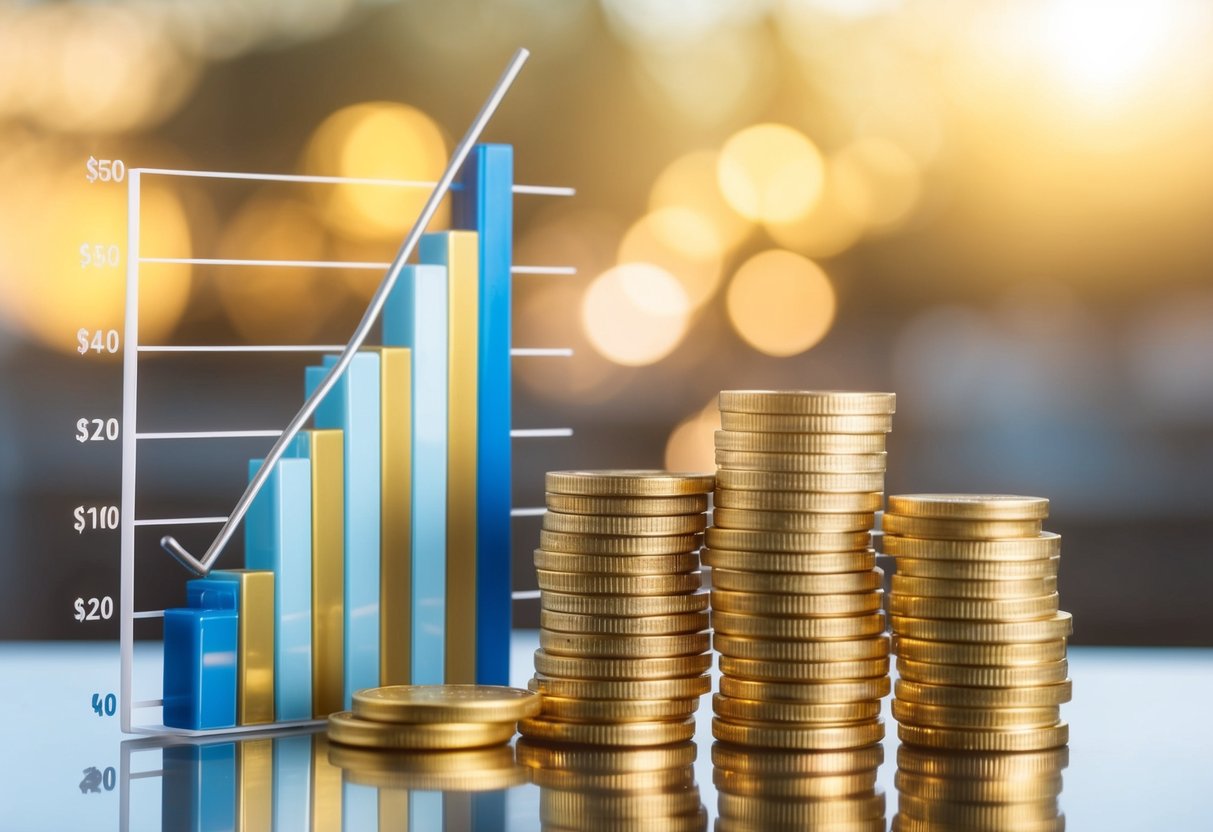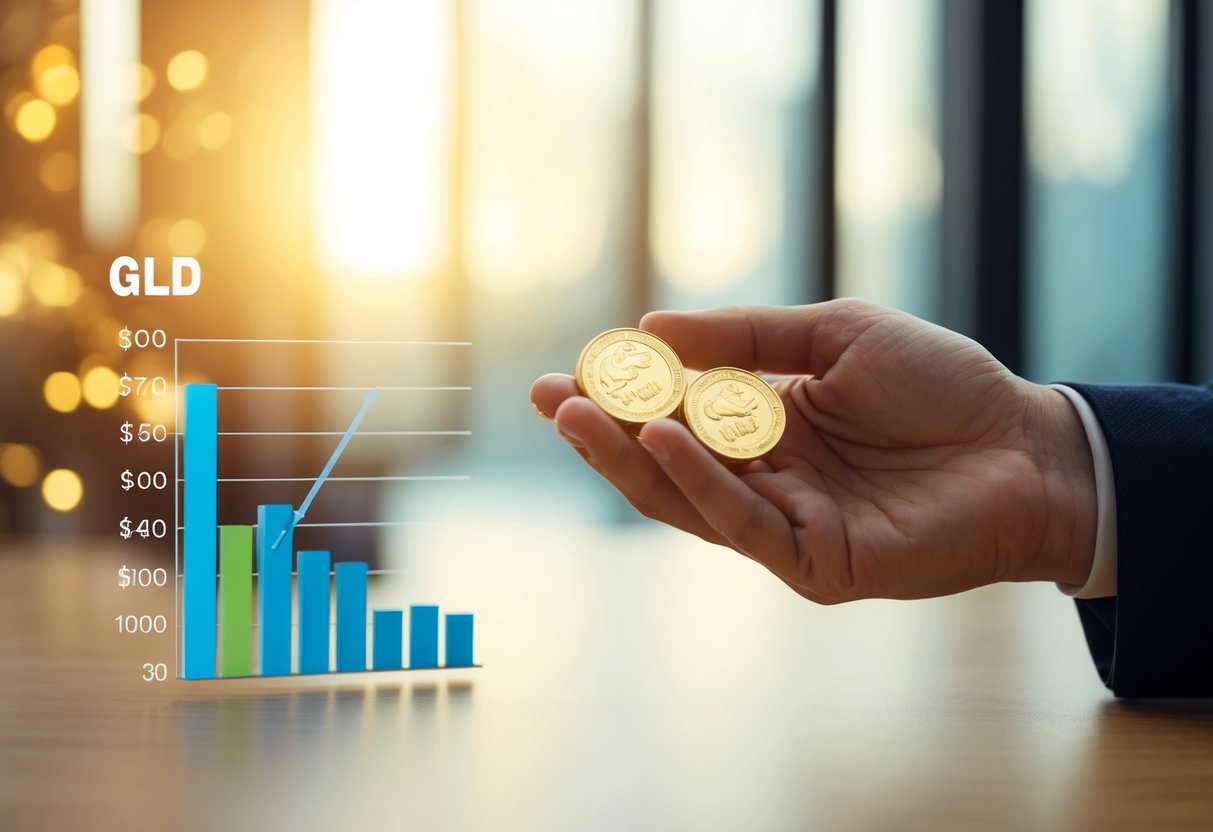
Why Physical Gold Instead of GLD
In times of economic uncertainty, investors often turn to gold for security. While ETFs like GLD offer a convenient way to invest in gold, many still prefer to hold physical gold. Owning physical gold provides a tangible asset with real monetary value that isn’t tied to the whims of financial markets. This appeal is heightened by the ability to store and physically hold the investment, offering a sense of control and security.
Physical gold is recognized for its stability and has been trusted for centuries as a store of value. Unlike gold ETFs, which carry fees for management and storage, owning physical gold means investors have control over how they store and secure their assets. Those who choose physical gold often appreciate its independence from the digital financial system, providing a direct hedge against inflation and market volatility.
Physical gold and ETFs have unique benefits. Physical gold is a dependable choice for those focused on security and tangible ownership. Despite the convenience of ETFs, physical gold offers an unmatched level of personal control and resilience in the face of economic fluctuations.
Key Takeaways
- Physical gold offers tangible ownership and control.
- Gold ETFs provide convenience but involve fees.
- Physical gold is a stable asset for economic security.
Download our “Free Gold Report PDF“.
The Essentials of Physical Gold Investment

Physical gold, such as coins or bullion, offers a tangible investment and a sense of ownership. Unlike Gold ETFs, it does not rely on electronic records. This section explores the key aspects of investing in physical gold, highlighting its advantages over ETFs.
Understanding Physical Gold
Physical gold refers to actual gold investors, such as bars or coins, can hold. This makes it a tangible asset, providing a sense of security that electronic funds cannot match. Investing in gold generally involves buying these physical forms and storing them securely.
When purchasing physical gold, it is essential to consider purity. The gold content is usually measured in karats or percentages, with 24 karats being pure gold. Gold coins and bars often come with authenticity certificates, verifying their purity and weight. This step assures the buyer of the quality of gold they are purchasing.
Benefits of Physical Gold Over Gold ETFs
Owning physical gold carries several advantages over Gold ETFs. One crucial aspect is control and direct ownership. Investors hold the gold without any intermediary managing the asset. This direct ownership removes concerns over fund management or the potential collapse of electronic systems.
Physical gold is not subject to the same market risks as ETFs. Economic factors like inflation typically affect the price of gold, but gold itself can’t default or go bankrupt. This quality makes physical gold a reliable form of investment during market instability.
The Tangibility of Gold Bullion
Gold bullion is valued for its tangibility. A physical item can be stored securely outside the financial system. This feature offers investors a hedge against digital market failures or a global economic crisis. Buying physical gold like bullion provides a tactile experience and peace of mind, something that gold stocks or funds cannot offer.
Storage can be a concern but also adds a layer of security. Investors can store gold at home or in a secure vault, allowing them control over their investment’s physical state. Holding actual gold is reassuring for those concerned about intangible or digital investment risks.
Financial Security and Risk Management

Investing in physical gold can offer substantial financial security, especially when market conditions are unstable. Unlike gold ETFs like GLD, physical gold holds unique benefits in terms of risk management throughout economic changes.
Hedge Against Inflation and Currency Fluctuations
Physical gold is a hedge against inflation and the devaluation of fiat currencies like the U.S. dollar. When inflation rises, the value of paper money often decreases, but gold tends to maintain its purchasing power. As currencies fluctuate, physical gold provides a stable store of value, giving investors confidence. Since gold is not tied to any country’s currency, it offers protection against currency risks, making it an excellent choice during economic uncertainty.
Gold as an Insurance for Economic Downturn
Gold is often seen as a safe haven during economic downturns. When the market experiences a drop, gold’s tangible nature provides security to investors. Unlike stocks, bonds, or currencies, gold’s value often remains stable or increases when other investments are volatile. This makes gold an effective form of insurance. Physical gold is an attractive option for investors seeking to preserve wealth through unforeseen financial crises. Its historical resilience during market drops enriches its reputation as a rock-solid investment choice.
Counterparty Risk and GLD
Investing in physical gold significantly reduces counterparty risk compared to GLD and other gold ETFs. When purchasing a gold ETF, there is a degree of reliance on financial institutions, which involves risks such as defaults or economic distress. In contrast, buyers of physical gold own a tangible asset, eliminating dependence on any party to honor claims. This independence is crucial in turbulent financial environments, where counterparty risks are magnified. Therefore, for individuals prioritizing risk management and direct ownership, choosing gold bars or coins over ETFs like GLD becomes an apparent strategic decision.
Investment Portfolio and Diversification

Diversifying into physical gold versus gold stocks or ETFs like GLD can be a strategic move when investing in gold. Understanding how to balance these assets in a portfolio is crucial for effective risk management and potential returns.
Strategies for Portfolio Diversification
Diversifying an investment portfolio involves spreading holdings across different asset types to minimize risk. For example, adding physical gold can provide a tangible hedge against economic downturns. Physical gold is often seen as a safe-haven asset during volatile market periods, offering stability compared to paper assets.
Gold exposure can balance other investments that are more sensitive to market fluctuations. Investors should consider the stability that physical gold may offer, particularly in uncertain economic times.
Percent Allocation in Gold
Determining the proper percent allocation in gold requires analyzing individual risk tolerance and investment goals. Typically, financial advisors recommend keeping 5-10% of a portfolio in gold-related assets.
This allocation can help shield against inflation and currency depreciation. Unlike gold ETFs such as GLD, physical gold provides ownership of a real asset, which some investors find appealing for long-term wealth preservation.
Deciding on the right proportion of gold can be key to achieving a balanced and resilient portfolio.
Comparison with Gold Stocks and Mining Stocks
There are important differences to consider when comparing physical gold with gold stocks and mining stocks. Gold stocks and mining stocks represent shares in companies that mine and produce gold, often offering higher potential returns but with greater volatility.
Physical gold remains stable as its value doesn’t depend on company performance. Holdings in companies like gold miners can experience sharp price movements, reflecting market trends or operational issues.
Investors need to weigh the stability of physical gold against the growth potential and risks associated with gold stocks and mining stocks, tailoring their choices to meet specific investment objectives.
Purchasing and Storage Considerations

When buying physical gold, it’s crucial to consider both the logistics of purchase and storage security. Choosing the right dealers and storage options ensures the authenticity and safety of the investment.
Gold Purchase Logistics
Purchasing physical gold involves a process that requires careful attention. Buyers need to consider transportation and insurance to protect their investment from the start. Transportation can be risky without adequate insurance, so arranging for coverage during transit is important. When planning a purchase, custodian services might offer a helpful solution. They assist in managing the logistics, providing both shipping and secure handling of the asset. Additionally, keeping records of all transactions is crucial for personal tracking and tax reporting purposes.
Choosing coins or bars is another aspect of purchasing that requires consideration. Coins may be easier for some to liquidate due to their smaller denominations. However, bars usually have a lower premium over the spot price of gold, offering more gold for each dollar spent. Each type has different implications for future resale, so buyers must match their choice with their investment goals. Understanding these details assists in making informed decisions about purchasing physical gold.
Selecting Reputable Dealers and Storage Facilities
Identifying a reputable dealer is a critical step in purchasing gold. Buyers should look for dealers with a proven track record and strong customer reviews. It’s also beneficial to check for accreditation from industry organizations. Authenticity is non-negotiable, and reputable dealers often provide certificates verifying the purity and weight of the gold.
Storage facilities should offer high-level security features. This includes things like alarm systems, 24/7 surveillance, and insurance options. Privacy is another factor to consider, as some investors seek discretion in their gold holdings. Gold storage facilities, such as those provided by banks or specialized providers, can ensure these requirements are met. The choice of storage can influence the ease of access and the level of protection against theft, adding another layer of consideration for physical gold investors.
Understanding the Costs and Fees

When deciding between purchasing physical gold or investing in GLD, it’s essential to consider the associated costs and fees. These can impact the overall return on investment and should align with the investor’s financial goals. Both options come with distinct financial implications and require a careful evaluation.
Expense Ratios of Gold ETFs vs. Storage Costs
Gold ETFs, such as GLD, come with expense ratios representing the fund’s annual fees. These ratios cover management and operational costs. Typically, ETFs have lower expense ratios ranging from 0.25% to 0.50% per year compared to storage costs for physical gold.
In contrast, owning physical gold involves additional costs for secure storage. These storage fees can vary depending on the method chosen, such as a bank vault or a private facility. Additionally, physical gold requires insurance to protect against theft or damage, adding another layer of expense. Buyers should weigh these storage costs against the relatively lower but ongoing fees of an ETF when making a decision.
Tax Efficiency and Implications
Tax considerations are crucial when investing in gold, whether in physical form or ETFs. Physical gold is considered a collectible, and sales are subject to capital gains tax rates, which can be as high as 28% in the U.S. This rate applies regardless of how long the gold is held, impacting long-term capital gains.
On the other hand, gold ETFs might offer more favorable tax treatment. Gains from selling ETF shares can be taxed at lower rates if held for over a year. This can be beneficial for investors seeking tax efficiency. However, they must be aware of any spot price fluctuations that could influence the tax implications of their sale. Understanding these differences helps investors make informed decisions tailored to their tax situations.
Liquidity and Access to Gold Markets

Liquidity and access are critical factors when investing in gold, whether physical gold or gold ETFs like GLD. The ease of trading and the platforms available can significantly affect an investor’s decision.
Tradeability of Physical Gold
Physical gold can be traded through various channels, offering direct access to the price fluctuations in the gold market. Investors can buy and sell physical gold through dealers, coin shops, and online platforms. This flexibility ensures that investors respond quickly to changing gold prices and market conditions.
Though physical gold offers direct tradeability, there can be logistical challenges. Transactions might involve travel and finding a reputable buyer or seller. These factors can impact the speed and ease of buying and selling. Additionally, physical gold must be stored securely, which could involve extra costs.
Unlike owning shares in gold ETFs, physical gold allows complete ownership. This direct control can be appealing to those seeking tangible assets without intermediaries. However, verifying authenticity and assessing market conditions are crucial to ensuring effective trading.
Online Trading Platforms and Brokerage Accounts
Online trading platforms and brokerage accounts have streamlined investing in gold. They offer convenient access to both physical gold and gold ETFs. Through these platforms, investors can monitor gold prices and buy and sell assets quickly, all through user-friendly interfaces.
Platforms often provide real-time updates on gold prices, making it easier to time purchases or sales based on the spot price. Most platforms also offer mobile apps for trading on the go, providing flexibility and enhanced monitoring capabilities.
For gold ETFs such as GLD, brokerage accounts facilitate trading like any stock, with added liquidity and minimal premiums over the spot price. This setup makes ETFs especially attractive for those looking for a more straightforward, less logistical means of investing in gold.
Legal and Security Factors

Security and legal aspects play a critical role when considering an investment in physical gold or GLD. Physical gold requires secure storage to prevent theft, while GLD involves different ownership responsibilities.
Security Issues in Physical Gold vs. GLD
Physical gold needs secure storage, which can be costly and risky. Theft is a significant concern, requiring robust security measures like safes or safety deposit boxes. Insurance for physical gold is also recommended, adding to expenses.
In contrast, gold exchange-traded funds like GLD offer digital security. Custodians hold the actual gold backing the shares, reducing personal risk. However, investors rely on these institutions for security, which involves trust in entities like the SPDR Gold Trust and iShares Gold Trust.
Ownership and Control
Owning physical gold gives direct control over the asset. Investors decide where and how to store it, offering complete leverage over their investment. Legal ownership is clear and direct, making transactions straightforward.
Meanwhile, GLD investors possess shares in a trust, not physical gold. A trustee manages the gold, and investors must trust the operational practices of institutions like BlackRock. While this setup offers convenience, it also means less personal control over the gold. Investors must understand the legal framework governing these trusts to ensure their investment aligns with their goals.
Evaluating Performance and Growth

Investors consider historical performance and prospects when choosing between physical gold and GLD. Understanding how these options perform in different market conditions can help guide investment decisions related to capital gains and portfolio stability. Analyzing market trends is crucial for those considering gold IRAs or other investment strategies in precious metals.
Historical Performance in Diverse Markets
Physical gold has often been viewed as a safe haven during financial crises. It maintains value better than many other investments, including gold exchange-traded funds (ETFs) like GLD. For example, during the 2008 financial crisis, physical gold prices rose sharply as investors sought stability. The tangible nature of gold can offer more security compared to gold funds, which might fluctuate more with market trends.
In different economic environments, physical gold often shows resilience. Over decades, it has provided steady growth. Even when stock markets falter, gold usually retains its appeal. This makes it a dependable choice for those looking to protect capital gains during uncertain times. The enduring popularity of physical gold can be linked to its performance when other assets falter.
Predicting Future Gold Prices and Market Trends
Predicting future prices involves considering factors such as economic downturns, inflation rates, and geopolitical tensions. Gold traditionally increases in value when confidence in currencies and financial systems declines. Analysts often suggest that future trends might see gold maintaining its role as a secure investment.
Investments in gold IRAs and physical assets are considered a hedge against inflation. As economic conditions fluctuate, investing in gold remains a strategic move. Though predicting exact prices is challenging, the consistent demand for precious metals suggests a promising outlook. Understanding these trends can help investors make informed decisions about their approach to gold investments.
Additional Investment Vehicles

Investors looking for alternatives to owning physical gold and GLD have options such as gold streamers and incorporating gold into retirement plans. These investment vehicles provide diverse ways to include gold in one’s financial strategy while considering different risk levels and potential returns.
Gold Streamers and Royalty Companies
Gold streamers finance mining companies in exchange for a percentage of the mine’s future revenue. This business model allows investors to gain exposure to the gold market without directly owning or mining gold. Streamers typically hold diversified portfolios, which can help spread risk.
Key example companies in this space include Franco-Nevada and Royal Gold. They offer benefits like access to gold prices and potential dividends. Relative to traditional mining companies, streamers usually face less operational risk as they don’t deal with the physical aspects of mining. However, they are still exposed to fluctuations in gold prices.
Gold streamers can be an appealing investment for those seeking a balance between risk and reward, providing growth and income opportunities.
Incorporating Gold into Retirement Plans
Including gold in retirement plans, mainly through a gold IRA, offers another way to invest in the yellow metal. A gold IRA allows investors to hold physical gold as part of their retirement portfolio, providing protection against economic downturns.
Investors must work with a custodian to manage the gold IRA and comply with legal regulations. The process involves choosing between different types of gold, like bullion coins or bars, depending on personal preferences and investment goals. Though not as liquid as stocks or bonds, gold in a retirement account can serve as a hedge against inflation and currency fluctuations.
This strategy can help diversify a portfolio, reducing overall vulnerability to market volatility and economic disruptions.
Frequently Asked Questions

Physical gold ownership offers distinct benefits, including control over assets, security, and tangible value. Gold ETFs offer convenience and easy trading but might not provide the same level of personal asset control.
What are the advantages of owning physical gold over a Gold ETF?
Owning physical gold gives investors direct control and ownership of a tangible asset. This provides a level of security and peace of mind that some investors may prefer. Additionally, physical gold isn’t subject to the management fees often associated with Gold ETFs like GLD.
How do the returns of investing in a Gold ETF compare to purchasing physical gold?
Gold ETFs track the price of gold and often offer lower expense ratios, potentially leading to different return dynamics compared to physical gold. Physical gold may incur costs for storage and insurance, which can impact net returns.
What are the tax implications of owning physical gold versus a Gold ETF?
The tax treatment of physical gold can be different from that of Gold ETFs. Physical gold is often considered a collectible for tax purposes, potentially leading to higher capital gains taxes. Gold ETFs might be taxed differently depending on jurisdiction and type of fund.
Can you explain the storage and insurance considerations for physical gold compared to Gold ETFs?
Physical gold requires secure storage, which can involve additional costs for safekeeping, whether at home or in a bank. Insurance is an important consideration to protect against loss or theft. In contrast, Gold ETFs are digital holdings and don’t require personal storage or additional insurance.
How does liquidity in the physical gold market compare to that of Gold ETFs?
Gold ETFs provide high liquidity, allowing investors to buy and sell shares easily on stock exchanges. Physical gold, while valuable, can be less liquid, requiring time and effort to sell in the market.
What are the potential risks and rewards of investing in physical gold over Gold ETFs?
Physical gold offers asset control and may protect against certain market risks. However, it involves costs of storage, insurance, and possibly higher taxes. Gold ETFs offer convenience and liquidity but come with management fees and no physical ownership. Balancing these factors is crucial for investors.


